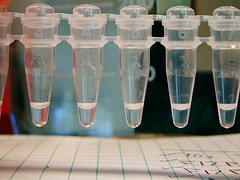Viability PCR (vPCR) is a big step forward in PCR technology. Through the use of a simple pre-treatment of the sample(s) of interest using specific intercalating reagents, it is possible to neutralize the DNA of dead cells. As a result, only DNA from live cells will be amplified by PCR.
Through the vPCR, it’s possible to quantify the levels of live microorganisms in clinical, food, and environmental samples. This will improve our understanding about the real infectious or spoiler potential of the microorganism(s) present in the sample.

(PhAST: photo activation system for tubes)
The principle of vPCR is based on the use of some photo-reactive azide forms of phenanthridinium, such as PMA (Propidium Monoazide) and EMA (Ethidium Monoazide). These DNA intercalating dyes are unable to diffuse through intact cell membranes. These reagents are able to enter the dead cell due to the loss of membrane integrity and intercalate or neutralize its DNA .
Following the intercalation of these reagents into the DNA of the dead cells, the cells are treated with a blue light (460 nm) to irreversibly bind the reagent to the DNA. Consequently, this DNA-reagent complex that forms only in the dead cells can not be amplified by DNA polymerase and won’t be detected.
There are several published procedures based on this approach for the detection of various microorganisms, such as viruses, bacteria, fungi and parasites.
vPCR is compatible with a wide range of qPCR reagents and protocols. However, oftentimes an existing qPCR method must be tweaked to get proper entry of the reagent into the dead cells. Unfortunately, it’s not always as simple as addin the intercalating reagent directly to the cells. The following needs to be considered in order to get optimal entry and binding of the reagent to the dead cells DNA, otherwise known as dead cell DNA neutralization (for more detail read refs 1,2):
- The appropriate selection of the dye and its concentration: Currently, there are two reagents available: EMA and PMA. The first one is more effective, but can penetrate some living bacterial cells. The ranges of concentrations are from 25 µM to 200 µM.
- It’s necessary to incubate cells with reagents during a short time period, minimizing the impact on overall cell viability but optimizing reagent diffusion through dead cells.
- Temperature affects cell membrane stability, which disproportionately affects the integrity of dead cell membranes. You can alter the temperature you when you incubate the reagent with your cells to selectively increase the diffusion of the reagent into the dead cells.
- This procedure is based on a photochemical reaction that needs a lot of energy. Conventional halogen lamps can overheat the sample, so specific devices based on LED technology that have constant light delivery, specific wavelength, and stable temperature are more appropriate.
- Lastly research shows that large amplicons are more compatible with the vPCR approach, most likely because the probability that your PCR will encounter a DNA-reagent complex increases with length.
Despite this additional work for adapting your current PCR procedure, the potential of this approach is very high. Until recently this has only been reported in many scientific papers, but now the first commercial products and kits are on the market.
References
- Fittipaldi M, Nocker A, Codony F. (2012) Progress in understanding preferential detection of live cells using viability dyes in combination with DNA amplification. J Microbiol Methods. 91:276-89.
- Elizaquível P, Aznar R, Sánchez G. (2014) Recent developments in the use of viability dyes and quantitative PCR in the food microbiology field. J Appl Microbiol. 116:1-13.






